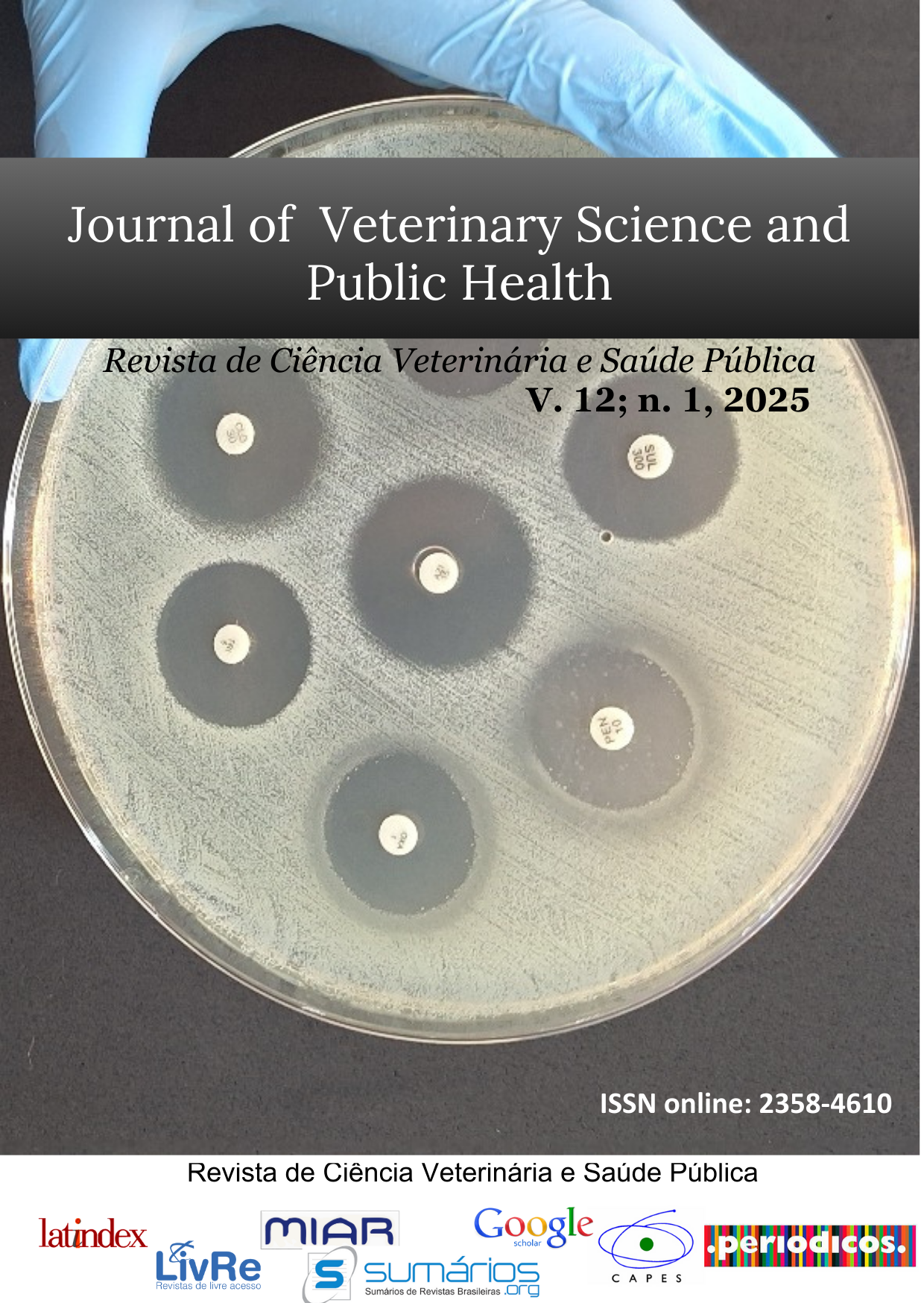Pharmacodynamic effects of intranasal ketamine in cats
Abstract
A cetamina é um fármaco versátil e amplamente utilizado em diversos contextos clínicos. É comumente administrada pela via intravenosa, entretanto, diversos estudos apontam a sua utilização em rotas alternativas, como via intranasal. O presente estudo teve como objetivo avaliar os efeitos cardiovasculares, respiratórios e sedativos da cetamina após a administração pela via intranasal em gatos. O experimento foi desenvolvido com seis gatos (n = 6) subdivididos em grupo intravenoso (IV) e intranasal (IN), nos quais receberam cetamina nas doses de 2 mg/kg e 5 mg/kg, respectivamente. Foram avaliados os parâmetros fisiológicos e grau de sedação dos animais antes e após a administração do fármaco. Os dados foram submetidos à análise estatística através do Teste de Shapiro-Wilk e Teste de Kruskal-Wallis, além da avaliação descritiva. Os resultados demonstraram efeitos semelhantes entre os dois tratamentos (p > 0.05), sendo que o escore de sedação foi significativamente diferente para o grupo IV em até 20 minutos após a administração da cetamina. O principal efeito adverso observado imediatamente após a administração da cetamina pela via intranasal foi a salivação, enquanto pela via intravenosa foram midríase e rigidez muscular. A cetamina é um fármaco que apresenta ampla janela terapêutica e a visualização dos seus efeitos variam de acordo com a dose utilizada. Os efeitos fisiológicos e sedativos da cetamina foram similares entre o grupo intranasal e intravenoso, e não houve alterações relevantes em comparação aos valores basais.
Downloads
Riferimenti bibliografici
BURNETT, A.M.; PETERSON, B.K.; STELLPFLUG, S.J.; ENGEBRETSEN, M.K.; GLASRUD, K.J.; MARKS, J.; FRASCONE, R.J. The association between ketamine given for prehospital chemical restraint with intubation and hospital admission. American Journal of Emergency Medicine, v.33, p.76–79, 2015.
CONWAY, J. A. et al. Ketamine Use for Tracheal Intubation in Critically Ill Children Is Associated With a Lower Occurrence of Adverse Hemodynamic Events. Critical Care Medicine, v. 48, n. 6, 2020.
DENG, M.; CHEN, S.; PAN, H. Presynaptic NMDA receptors control nociceptive transmission at the spinal cord level in neuropathic pain. Cellular and Molecular Life Sciences, v.76, p.1889–1899, 2019.
ERDŐ, F.; BORS, L.A.; FARKAS, D.; BAJZA, A.; GIZURARSON, S. Evaluation of intranasal delivery route of drug administration for brain targeting. Brain Research Bulletin, v.143, p.155-170, 2018.
BOUVIER, G.; BIDORET, C.; CASADO, M.; PAOLETTI, P. NEUROSCIENCE FOREFRONT REVIEW PRESYNAPTIC NMDA RECEPTORS: ROLES AND RULES. Neuroscience, p.322-340, 2015.
GUTHRIE, A.M.; REGAN A. BAUM, R.A.; CARTER, C.; DUGAN, A. JONES, L.; TACKETT, T.; M. BAILEY, A.M. Use of Intranasal Ketamine in Pediatric Patients in the Emergency Department. Pediatric Emergency Care, v.00, n.00, 2019.
JELEN, L.A.; ALLAN H YOUNG, A.H.; M STONE, J.M. Ketamine: A tale of two enantiomers. Journal of Psychopharmacology, v.35, n.2, p.109-123, 2021.
LI, L.; VLISIDES, P.E. Ketamine: 50 Years of Modulating the Mind. Frontiers in Human Neuroscience, v.29, 2016.
LOCHHEAD, J.J.; DAVIS, T.P. Perivascular and Perineural Pathways Involved in Brain Delivery and Distribution of Drugs after Intranasal Administration. Pharmaceutics, v.11, 2019.
LUNGARE, S.; BOWEN, J.; BADHAN, R. Development and Evaluation of a Novel Intranasal Spray for the Delivery of Amantadine. Journal of Pharmaceutical Sciences, v.105, n.3, p.1209-1220, 2016.
MARJANI, M.; VAHID AKBARINEJAD, V.; BAGHERI, M. Comparison of intranasal and intramuscular ketamine midazolam combination in cats. Veterinary Anaesthesia and Analgesia, v.42, p.178–181, 2015.
PELTONIEMI, M.A.; HAGELBERG, N.M.; OLKKOLA, K.T.; SAARI, T.I. Ketamine: A Review of Clinical Pharmacokinetics and Pharmacodynamics in Anesthesia and Pain Therapy. Clinical Pharmacokinetics, 2016. DOI 10.1007/s40262-016-0383-6
MCINTYRE, R.S. et al. Synthesizing the Evidence for Ketamine and Esketamine in Treatment-Resistant Depression: An International Expert Opinion on the Available Evidence and Implementation. American Journal of Psychiatry, v.178, n.5, p.383-399, 2021.
MILLER, A.C; JAMIN, C.T.; ELAMIN, E.M. Continuous intravenous infusion of ketamine for maintenance sedation. Minerva Anestesiologica, v.77, n.8, 2011.
MOHRIEN, K.M.; JONES, G.M.; MACDERMOTT, J.R.; MURPHY, C.V. Remifentanil, Ketamine, and Fospropofol A Review of Alterative Continuous Infusion Agents for Sedation in the Critically Ill. CRITICAL CARE NURSING QUARTERLY, v.37, n.2, p.137–151, 2014.
NOWACKA, A.; BORCZYK, M. Ketamine applications beyond anesthesia – A literature review. European Journal of Pharmacology, v.860, 2019.
POONAI, N.; CANTON, K.; ALI, S.; HENDRIK, S.; SHAH, A.; MILLER, M.; JOUBERT, G.; RIEDER, M.; HARTLING, L. Intranasal ketamine for procedural sedation and analgesia in children: A systematic review. PLoS ONE, v.12, n.3, 2017.
RACHED-D'ASTOUS, S.; FINKELSTEIN, Y.; BAILEY, B.; MARQUIS, C.; LEBEL, D.; DESJARDINS, M.; TROTTIER, E.D. Intranasal ketamine for procedural sedation in children: An open-label multicenter clinical trial. American Journal of Emergency Medicine, v.67, p.10–16, 2023.
RADVANSKY, B.M.; PURI, S.; ANTHONY N. SIFONIOS, A.N.; ELOY, J.D.; LE, V. Ketamine—A Narrative Review of Its Uses in Medicine. American Journal of Therapeutics, v.0, p.1–13, 2015.
SAWYNOK, J. Topical and Peripheral Ketamine as an Analgesic. Survey of Anesthesiology, v.119, n.1, p.170-178, 2014. DOI:10.1213/ANE.0000000000000246
TRAYNOR, K. Esketamine nasal spray approved for treatment-resistant depression. American Journal of Health-System Pharmacy, v.76, n.9, 2019.
VLERICK, L.; DEVREESE, M.; PEREMANS, K.; DOCKX, R.; CROUBELS, S.; DUCHATEAU, L.; POLIS, I. Pharmacokinetics, absolute bioavailability and tolerability of ketamine after intranasal administration to dexmedetomidine sedated dogs. PLoS ONE, v.15, 2020.
XIONG, J.; LIPSITZ, O.; CHEN-LI, D.; ROSENBLAT, J.D.; RODRIGUES, N.B.; CARVALHO, I.; LUI, L.M.W.; GILL, H.; NARSI, F.; MANSUR, R.B.; LEE, Y.; MCINTYRE, R.S. The acute antisuicidal effects of single-dose intravenous ketamine and intranasal esketamine in individuals with major depression and bipolar disorders: A systematic review and meta-analysis. Journal of Psychiatric Research, v.134, p.57-68, 2021.








